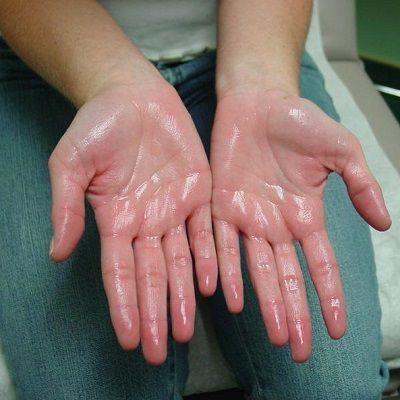Reliable Dermatology Solutions for Excessive Sweating: How to Stop Sweaty Hands and Feet
Reliable Dermatology Solutions for Excessive Sweating: How to Stop Sweaty Hands and Feet
Blog Article
Unveiling the Intricacies of Excessive Sweating: A Comprehensive Overview to Medical Diagnosis and Management
Too much sweating, medically known as hyperhidrosis, is a condition that affects a significant number of individuals and can have a profound effect on their high quality of life. While sweating is a natural bodily feature, its overactivity in hyperhidrosis presents an unique set of obstacles that usually go past plain pain.

Understanding Hyperhidrosis Causes
Hyperhidrosis creates can be associated to different elements such as genes, hormone inequalities, and particular medical conditions. Genetics play a significant role in key focal hyperhidrosis, where people inherit the problem from their relative. This kind of hyperhidrosis frequently manifests in details locations like the hands, soles of the feet, underarms, and face. Hormone inequalities, specifically an over active thyroid gland or menopausal changes, can also trigger excessive sweating. Additionally, particular clinical conditions such as diabetes mellitus, cardiovascular disease, and infections can cause additional generalized hyperhidrosis. These underlying wellness issues can interfere with the body's natural cooling system, creating the sweat glands to come to be overactive. Understanding the source of hyperhidrosis is vital in identifying and effectively managing this condition. By recognizing the particular variables adding to too much sweating, doctor can customize therapy strategies to attend to the underlying cause, supplying relief and boosting the lifestyle for people affected by hyperhidrosis.
Recognizing Hyperhidrosis Manifestations

Furthermore, hyperhidrosis symptoms might show up in social and psychological distress, as individuals might feel ashamed or anxious concerning their sweating, resulting in evasion of social circumstances (Exessive Sweating). In addition, duplicated episodes of excessive sweating can cause skin maceration, fungal infections, and a general decrease in self-worth
Diagnostic Process for Hyperhidrosis
Initiating the analysis process for too much sweating involves thorough analysis of the individual's clinical history and physical examination. Making inquiries about the start, duration, and causes of sweating episodes is vital to distinguish in between primary focal hyperhidrosis and second generalized hyperhidrosis. Case history must also include inquiries about medicines, medical conditions, and family members history of hyperhidrosis.
Throughout the checkup, specific focus is paid to the areas impacted by sweating. The doctor might evaluate the level of sweating, look for signs of underlying problems, and review the impact of sweating on the individual's top quality of life. Additionally, certain examinations like the gravimetric examination, starch-iodine examination, or skin conductance measurements may be carried out to evaluate the amount of sweat produced.
Moreover, in instances where second hyperhidrosis is presumed, extra tests such as blood examinations, pee examinations, and imaging research studies might be suggested to determine the underlying reason for too much sweating. The analysis procedure intends to properly establish the kind and reason of hyperhidrosis to assist ideal monitoring methods.
Therapy Choices for Hyperhidrosis
When attending to excessive sweating, different therapy choices are here are the findings available to reduce symptoms and improve the person's lifestyle. The therapy method for hyperhidrosis depends on the severity of signs and symptoms and the person's action to preliminary therapies.
Topical therapies, such as aluminum-based antiperspirants, are commonly recommended as the initial line of defense for taking care of mild instances of hyperhidrosis. For individuals with extra serious signs and symptoms, oral drugs like anticholinergics may be recommended to help reduce sweating.

Effective Management Techniques
To successfully handle hyperhidrosis, a detailed and customized therapy plan tailored to the client's specific needs and response to previous treatments is essential. This strategy might integrate a combination of therapeutic approaches, including way of living alterations, topical therapies, oral medications, botulinum contaminant shots, iontophoresis, and in serious cases, surgical treatments like sweat gland removal or sympathectomy. Lifestyle alterations such as using moisture-wicking clothes, using antiperspirants, and exercising stress-reducing methods can complement clinical treatments. Topical antiperspirants including light weight aluminum chloride are commonly the first-line treatment, with stronger solutions available for immune situations. Dental medications like anticholinergics might be recommended for generalised hyperhidrosis. Botulinum contaminant injections work for focal hyperhidrosis, supplying short-term alleviation by obstructing the release of acetylcholine. Iontophoresis, including using a reduced electrical existing to decrease gland activity, can be beneficial for both palmoplantar and axillary hyperhidrosis. Surgical alternatives are generally booked for serious, refractory instances and require cautious consideration of benefits and threats. A multidisciplinary method entailing skin specialists, medical care medical professionals, and, if necessary, doctors, can optimize the monitoring of hyperhidrosis.
Conclusion
To conclude, hyperhidrosis is a condition characterized by extreme sweating, which can greatly influence a person's lifestyle. By recognizing the reasons, acknowledging the signs, and going through the diagnostic process, health care carriers can effectively manage this condition. Treatment options include topical drugs, dental medications, shots, and also procedures in severe situations. With proper medical diagnosis and management strategies, individuals struggling with hyperhidrosis can find alleviation and boost their overall well-being.
Too much sweating, clinically recognized as hyperhidrosis, is a problem that impacts a considerable number of individuals and can have an extensive effect on their top quality of life. By recognizing the certain elements adding to extreme sweating, medical care providers can customize treatment strategies to attend to the underlying reason, supplying relief and improving the high quality Homepage of life for people influenced by hyperhidrosis.
Hyperhidrosis, identified by too much sweating beyond what is needed for regulating body temperature, can considerably affect an individual's quality of life. Asking about the beginning, period, and activates of sweating episodes is vital to separate between main focal hyperhidrosis and second generalized hyperhidrosis. Treatment for hyperhydrosis of hands.In verdict, hyperhidrosis is a condition identified by extreme sweating, which can greatly influence an individual's top quality of life
Report this page